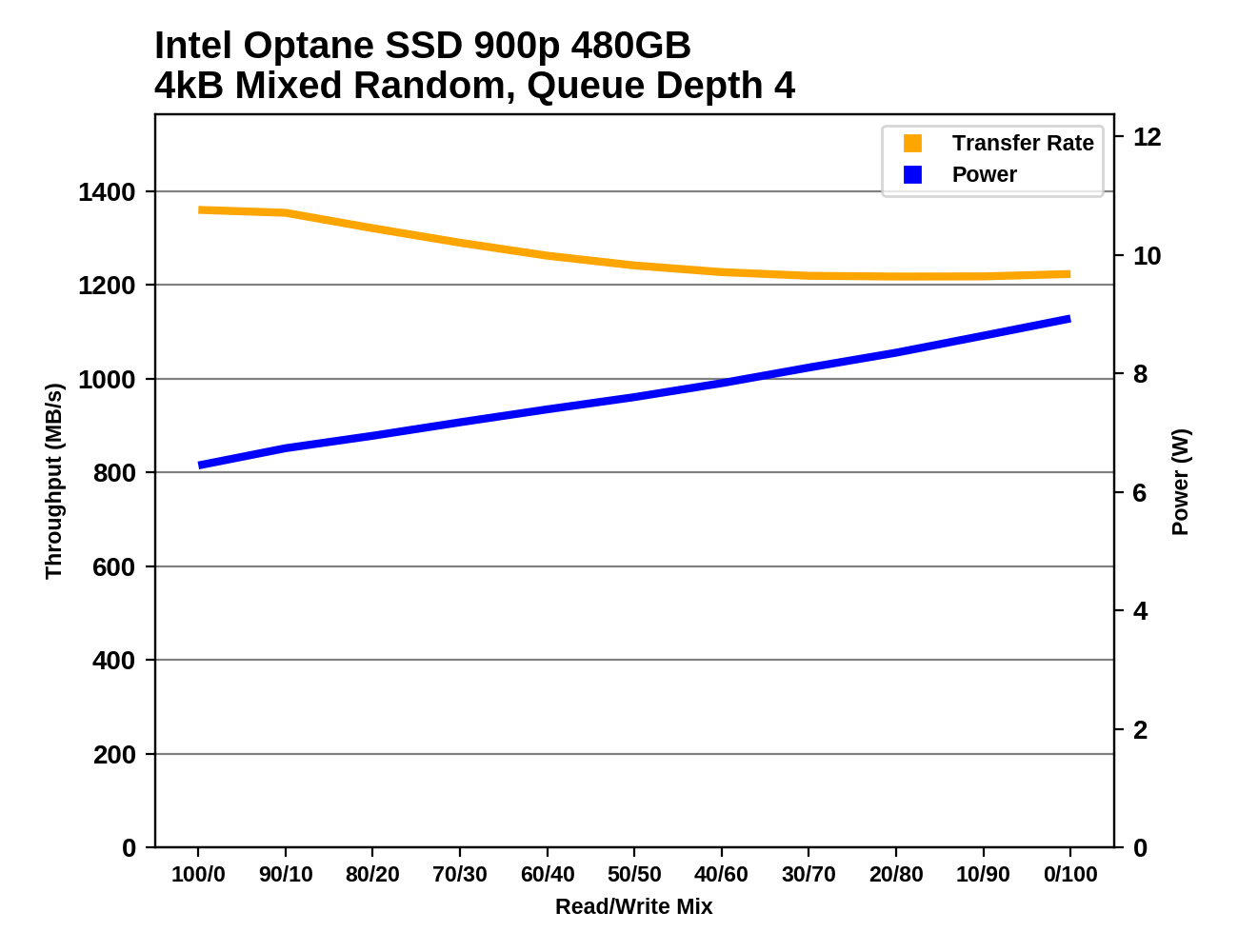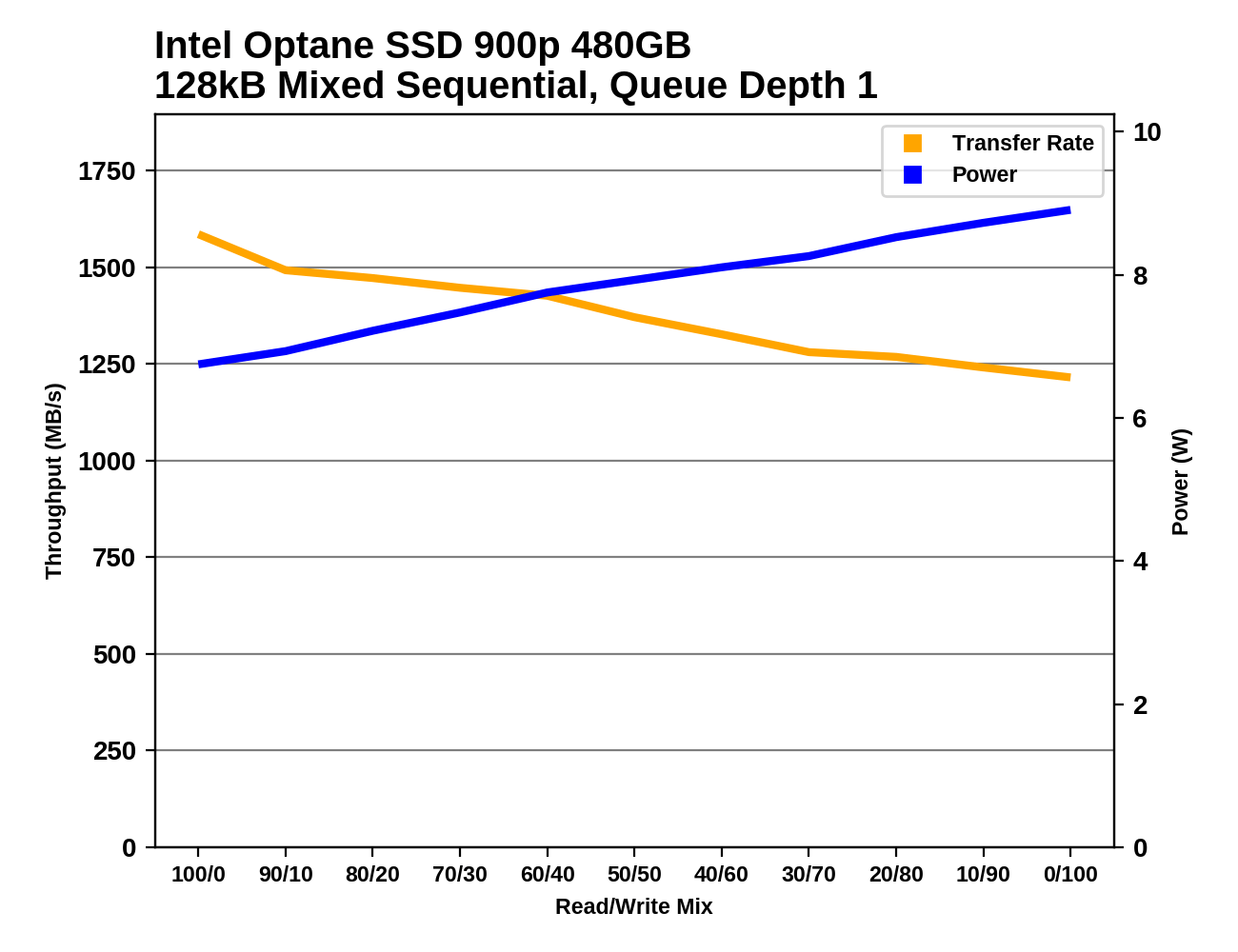The Intel Optane SSD 900p 480GB Review: Diving Deeper Into 3D XPoint
by Billy Tallis on December 15, 2017 12:15 PM ESTMixed Random Performance
Our test of mixed random reads and writes covers mixes varying from pure reads to pure writes at 10% increments. Each mix is tested for up to 1 minute or 32GB of data transferred. The test is conducted with a queue depth of 4, and is limited to a 64GB span of the drive. In between each mix, the drive is given idle time of up to one minute so that the overall duty cycle is 50%.

Since this mixed random I/O test is conducted at the relatively low queue depth of four, the Optane SSDs have a large performance advantage, and even the tiny Optane Memory M.2 does well (though it has to run a slightly modified version of the test due to its low capacity). The Optane SSDs are more than three times faster overall than the highest-scoring flash-based SSD.

The Optane SSDs have a substantial power efficiency lead on the mixed random I/O test, but it is small enough that flash-based SSDs could conceivably catch up with a generation or two of improvements. As usual, the 480GB model has clearly lower efficiency because its minor performance advantage doesn't outweigh the power cost the extra 3D XPoint memory chips.
 |
|||||||||
Both capacities of the Intel Optane SSD 900p show a modest decline in performance as the workload becomes more write-heavy, and a fairly linear increase in power consumption. The 480GB model's power consumption grows slightly faster than the 280GB model, leading to a 0.9W gap at the end of the test.
Even the Intel SSD 750 draws substantially less power for most of the test, though it catches up at the very end. The flash-based M.2 NVMe SSDs are mostly drawing a fraction of what the Optane SSDs require. In terms of performance, none of the flash-based SSDs come at all close to the Optane SSDs until the very end of the test, where many are able to deliver good random write speed.
Mixed Sequential Performance
Our test of mixed sequential reads and writes differs from the mixed random I/O test by performing 128kB sequential accesses rather than 4kB accesses at random locations, and the sequential test is conducted at queue depth 1. The range of mixes tested is the same, and the timing and limits on data transfers are also the same as above.

The Intel Optane SSD 900p is much faster on the mixed sequential I/O test than any consumer flash-based SSD. Samsung's best drives are slower by a third, and it's downhill from there for NAND flash. The 480GB model actually performed slightly worse on this test than the 280GB model, but the difference is small enough it may simply be due to variation between runs.

The power efficiency of the Optane SSD 900p on the mixed sequential I/O test is good but not quite at the top of the charts. Instead, it is on par with the Samsung 960 EVO, which sacrificed a bit of efficiency to improve performance relative to the Samsung 950 PRO.
 |
|||||||||
The 280GB Optane SSD 900p was a bit faster than the 480GB overall but a bit less steady over the course of the test. The scaling of the Optane SSDs is quite similar to the results from the mixed random test: a gradual decline in performance as the proportion of writes increases, and a linear increase in power consumption. The overall performance level is significantly higher than for the random I/O test.
The flash-based SSDs can get much closer to competing with the Optane SSDs on this mixed sequential test than on the mixed random test. Several drives have sequential read speeds that approach that of the Optane SSDs, and a few have higher sequential write performance. But through the middle portions of the test, the flash-based SSDs all lose a lot of their performance for at least a few phases of the test, while the Optane SSD has no acute performance weakness.










69 Comments
View All Comments
ddriver - Friday, December 15, 2017 - link
Which is MLC...Samsung realized nobody is catching up in the nand market and decided to push consumer, high end and mainstream enterprise a notch down to TLC.
So now that MLC is only a "high end enterprise" thing in their portfolio, they decided to pimp it up with a new moniker - z-nand. Alas, it is just good old MLC with a barely incremental controller. And claim that it has anything to do with SLC performance - which it does as much as an a race horse harness makes an old donkey faster.
They REALLY aren't trying.
mapesdhs - Monday, December 18, 2017 - link
Do you have a link to Intel's original PR articlea about this tech? Other people keep saying you're wrong, but if there is indeed a piece of Intel PR that at least implied an initial launch would provide the sort of speed gains you mention, then you absolutely have a point.jospoortvliet - Thursday, December 21, 2017 - link
I have no link, but as pointed out below, there is a fight with a strawman going on here. Intel certainly talked about 1000x improvement in latency of flash vs Optane - at that point they are talking about time it takes for a single flash cell vs an Optane cell. As Flash can only write to a block or more, it is far far slower, optane can address a single cell directly. And sure, that might very well be 1000x faster in theory - and even already in this very first Optane SSD.But, just like if you make one component (eg a piston) in a car engine 1000x faster the entire car won't drive 1000x faster - the other components also contribute to speed, as do external factors like, you know, wind, asphalt... So the car gets 10% faster as a whole. You see the same here: even if that one part is 1000x faster, flash controllers use a ram cache and splitting data over a dozen channels to overcome the inherent limitation of flash while the NVME protocol and PCIExpress puts limits at latency improvements, so the end result is that the Optane PCIE devices are occasionally >10x faster than SSD's but generally a factor 3-5.
Of course, if you put them in a DDR4 slot, they'll be unleashed a bit more and would beat a DDR4 SSD solution probably by a factor 30-50 in most cases with peaks of 100x. Still not 1000 and it'll never be...
So, in short, even if Intel is 100% correct and an individual cell responds 1000x faster, its response has to be mediated by the controller, go over a data bus etc etc. so you'll never measure it like that.
jospoortvliet - Thursday, December 21, 2017 - link
And of course Intel just screams '1000x faster response time' without very clearly identifying they're talking about a theoretical maximum. Well, it is marketing. You take the best looking numbers that are defensible and use them.eddman - Thursday, December 21, 2017 - link
No, intel claimed it for 3D xpoint, NOT optane. Xpoint is the name of the tech, optane is the storage devices based on the tech.Kidster3001 - Wednesday, January 3, 2018 - link
Intel never claimed Optane to be 1000x faster than anything. The 1000x faster was in reference to 3D-XPoint. XPoint = the memory cells; Optane = the SSD product line. Two completely different things.ddrіver - Saturday, December 16, 2017 - link
I'm not myself when I drink.farazgomot - Saturday, December 16, 2017 - link
I fully agree, why almost everybody is caustic to ddriver when he correctly is critic to only the marketing hype , not that the product is in any way bad ( except for the high price/ capacity)lmcd - Saturday, December 16, 2017 - link
He's arguing semantics when ridiculous performance claims are an industry norm. He's argued those semantics for 5 straight articles, and arguing with literally every comment he can find this very point. It's in the ballpark of 100 belligerent comments on 5 articles, which frankly is far closer to "caustic" than our collective treatment. It's fine if he states his opinion, but we're tired of being screamed at.Reflex - Saturday, December 16, 2017 - link
The problem with ddriver is that he is arguing against a strawman that was built up in his own mind. Optane was never promised to produce products that could deliver 1000x performance boosts in the first generation. PCM is itself as much as 1000x faster than traditional NAND for many operations while being orders of magnitude more durable.However the fact that you are using Optane/PCM does not in some way fix the fact that controllers aren't capable of that kind of performance yet, that PCIe bandwidth is way behind that level, that system memory, chipsets and CPU's couldn't keep up with that, that the software stack is not optimized for that, etc etc.
Intel delivered, mostly on time and for a cheaper price than is typical for a first gen of a new technology. Since they have previously stated what the performance capabilities of Optane/PCM are, the focus now will be on other aspects of the platform in order to enable that capability. This removes a major performance roadblock as they move towards an optical bus and optical chips, and ensures that system storage is not the long pole.
I'm fairly excited, its been ten years since any major change in storage has occurred and now it is finally here. And its reasonably priced for what it delivers from the get go.